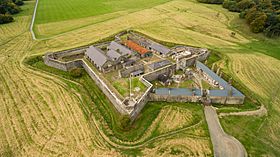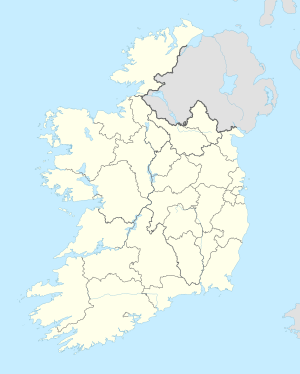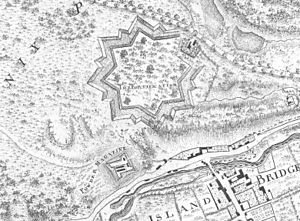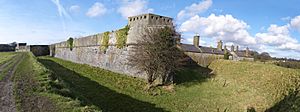Magazine Fort facts for kids
Quick facts for kids Magazine Fort |
|
|---|---|
| Dún na hArmlainne | |
| Near Phoenix Park, Dublin in Ireland | |

Aerial (drone) image of Magazine Fort
|
|
| Coordinates | 53°20′55″N 6°18′59″W / 53.3486°N 6.3163°W |
| Type | Bastion fort and magazine |
| Site information | |
| Owner | Office of Public Works |
| Open to the public |
Partial |
| Condition | Somewhat derelict |
| Site history | |
| Built | 1735 |
| Built by | John Corneille (military engineer) |
| In use | 1980s (demilitarisation) |
| Events | Easter Rising (1916), Christmas Raid (1939) |
| Garrison information | |
| Occupants | British Armed Forces, Irish Defence Forces |
The Magazine Fort is a strong building with thick walls, like a small castle. It was built to store gunpowder and other military supplies. You can find it inside the famous Phoenix Park in Dublin, Ireland.
This fort was built way back in 1735. For a long time, the British Armed Forces used it. Then, in 1922, after the Anglo-Irish Treaty, it was given to the Irish Defence Forces. The Irish Army kept using it to store ammunition until the 1980s. After that, it was no longer used for military purposes.
Today, the Office of Public Works looks after the fort. By 2015, it was quite old and falling apart. However, some repairs have been done since 2016. Now, you can even take special guided tours to explore parts of it!
Contents
History of the Fort
Why Was the Fort Built?
Long ago, in the 1530s, some land that is now part of Phoenix Park was taken from a group called the Knights Hospitaller. This land was later rented out, and a house called "Phoenix Lodge" was built there.
By the mid-1600s, the house and land became state property. It was even used by the Lord Deputy of Ireland, a very important official.
In the 1730s, the Lord Lieutenant of Ireland, Lionel Sackville, decided a new place was needed to store gunpowder. So, Phoenix Lodge was taken down in 1734. Construction of the Magazine Fort began in 1735. It was designed by an engineer named John Corneille.
At that time, Dublin wasn't a very rich city. A writer named Jonathan Swift even wrote a poem about the fort. He wondered why they were building a fort when there wasn't much left to defend!
How the Fort Was Built
The Magazine Fort is made of strong brick and limestone. It's different from an older fort nearby that was mostly made of earth.
The main part of the fort covers about two acres. It's surrounded by a dry ditch called a moat. Each corner has a special half-bastion with openings for guns. The walls are very thick, about 1.5 meters (5 feet) wide!
Inside, there are large, arched rooms made of brick. These were the actual magazine chambers where gunpowder was stored. They are about 270 square meters (2,900 sq ft) in size. Cranes and tracks were used to move heavy barrels of gunpowder around. Later, in 1801, a triangular barracks building was added for soldiers to live in. Other small buildings were added in the 20th century.
Fort Defences
A survey from 1793 shows that a large cannon was used to protect the main gate. By the 1890s, the fort had ten 12-pounder guns. In the early 1900s, the corner bastions were changed to include concrete machine-gun posts, like small bunkers.
Famous Raids on the Fort
The fort was used by British and Irish forces for 250 years. During that time, it was attacked twice in the 20th century.
The first attack happened on April 24, 1916, during the Easter Rising. Young members of a group called Fianna Éireann raided the fort. They wanted to get weapons and tried to blow up the fort. However, the fuses they set burned out before reaching the ammunition, so not much damage was done.
Some people believe the very first shots of the Easter Rising were fired during this raid. An unarmed person from the fort's staff and an armed guard were shot. The guard was badly hurt but lived. The unarmed person died a few hours later. These were the first shootings of the Easter Rising.
The second attack happened on December 23, 1939. This was known as the "Christmas Raid". Members of the Irish Republican Army raided the fort. They stole weapons and over a million rounds of ammunition! Luckily, most of the stolen items were found in the following weeks.
The Fort Today
After the Anglo-Irish Treaty, the Irish defence forces took control of the fort from the British. The Irish Army continued to use it, including as an ammunition store, until 1988. Then, it was given to the Office of Public Works (OPW).
For a while, the fort was quite run down. But by 2016, some repairs were made. This allowed parts of the fort to be opened to the public, especially for events celebrating the 100th anniversary of the 1916 Rising.
As of 2019, conservation work is still happening at the fort. The OPW offers guided tours on Sundays from April to October. These tours start from the Phoenix Park visitor centre.





